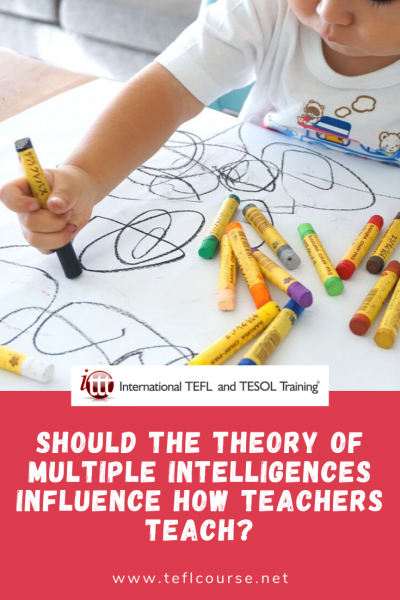Should the Theory of Multiple Intelligences Influence How Teachers Teach?

For almost a hundred years the IQ test, which tested reading and logical skills, was used to determine a person’s general intelligence. Howard Gardener, a Harvard psychologist found this idea too limiting and in 1983 introduced his theory of multiple intelligences, where intelligence is made up of more diverse skills.
This post was written by our TEFL certification graduate Anthony B. Please note that this blog post might not necessarily represent the beliefs or opinions of ITTT.
Gardener initially listed 7 intelligences:
- Linguistic intelligence, the ability to read, write and communicate with words.
- Logical-mathematical intelligence, the ability to reason and calculate.
- Musical intelligence, the ability to create, communicate and understand meanings made out of sound.
- Bodily-kinesthetic intelligence, the ability to use all or part of one’s body to create products, solve problems, or present ideas.
- Spatial intelligence, the ability to think in pictures and visualize future results.
- Interpersonal intelligence, the ability to understand and connect with other people.
- Intrapersonal intelligence, the ability to understand yourself and know who you are and what you can do.
Later, an eighth intelligence was added:
- Naturalist Intelligence, the ability to distinguish among, classify, and use features of the environment.

Also Read: 5 Questions about English for Specific Purposes
Principles of Intelligences Development
The extent to which the various intelligences develop significantly depends on a person’s education and culture and no two people have the same intelligences in the same combination and no single test can measure how well a person would perform a cognitive task. As people develop skills or solve problems they use multiple intelligences at the same time in a complementary manner.
It is clear that children learn differently, or have different ‘learning styles’. The theory of multiple intelligences appeared to validate this idea and led educators to develop new approaches that could better meet the needs of the range of learners in a classroom. However, over time ‘multiple intelligences’ somehow became synonymous with the concept of ‘learning styles’ something that Gardener himself does not agree with. The multiple intelligence theory is not supposed to be used to teach a child using only their strongest intelligences.
Also Read: 4 Essential Tools For Teaching ESL Online
Doubts on the Gardener’s Theory
Paul-Howard Jones, professor of neuroscience and education at the University of Bristol says that the belief that students learn better when they receive information tailored to their preferred learning styles is a myth.
Gardener does agree that multiple intelligence theory can be used in the classroom. According to Gardener, students should be given multiple ways to access information, which not only makes the lessons more engaging but students will be more likely to remember information presented in different ways. When individualizing lessons the teacher should think about student’s needs and interests. Incorporating art into lessons allows students to express themselves in different ways.

Presenting materials in various ways conveys what it means to understand something well. When one has a thorough understanding of a topic, one can typically think of it in several ways. If you can only teach in one way, your understanding is likely to be thin.
Gardener warns not to label students with a particular type of intelligence or ‘learning style’ as this can be harmful and discourage students from exploring other ways of thinking and learning or developing their weaker skills.
Do not try to match a lesson to a student's perceived learning style
In summary, the theory of multiple intelligences should influence how teachers teach to the point that the method of one-style-fits-all teaching should be avoided and a teacher should consider students’ needs and interests when designing a lesson. Presenting the information in several different ways that use a range of the students’ multiple intelligences is more likely to be remembered. Do not try to label a student's learning style and do not try to modify lessons based on those perceived labels, it is unnecessary and possibly harmful.
Do you want to teach English abroad? Take a TEFL course!
Apply now & get certified to teach english abroad!
Speak with an ITTT advisor today to put together your personal plan for teaching English abroad.
Send us an email or call us toll-free at 1-800-490-0531 to speak with an ITTT advisor today.
Related Articles:
- How do I get a job teaching English in South Korea
- 10 Questions You Need to Ask Before Enrolling In a TEFL Course
- The 10 Best Destinations for Teaching English Abroad in 2018
- Online or In-Class - Which TEFL Course Should You Take?
- The Best Government Programs For Teaching English Abroad
- What Scams to Look Out for When Looking for TEFL Jobs




